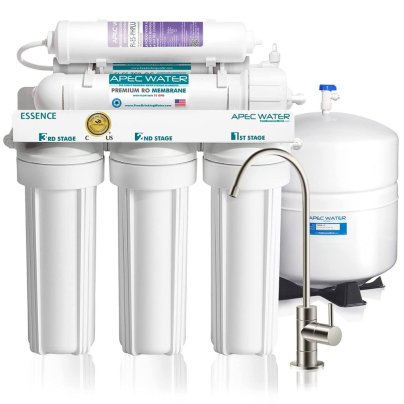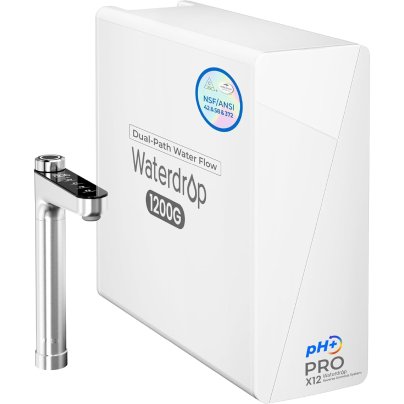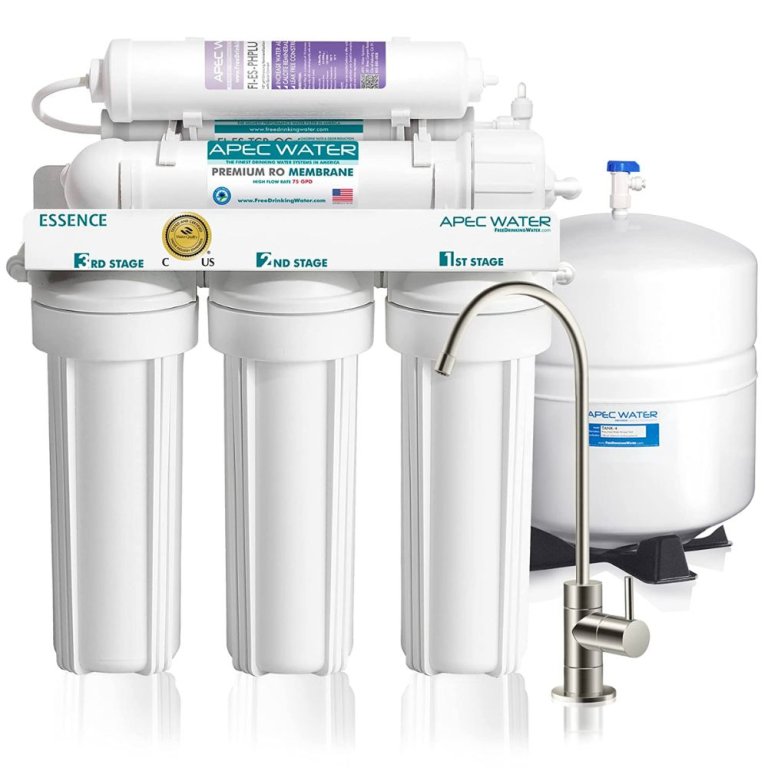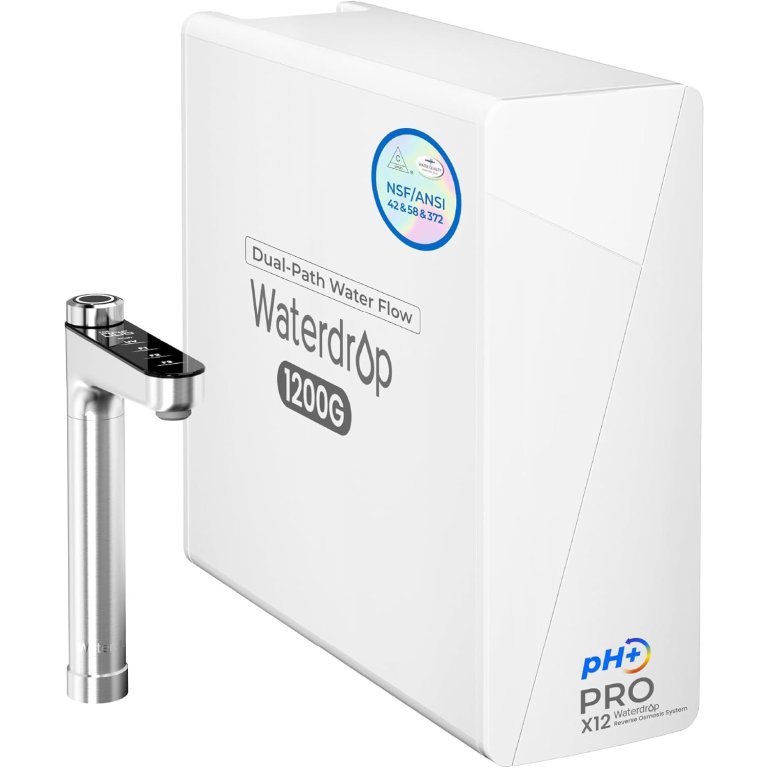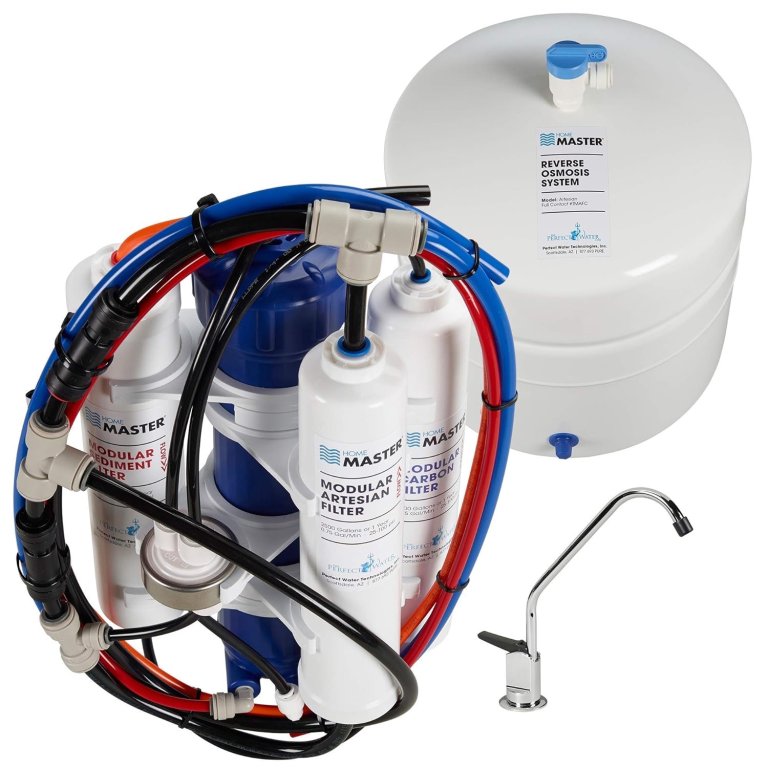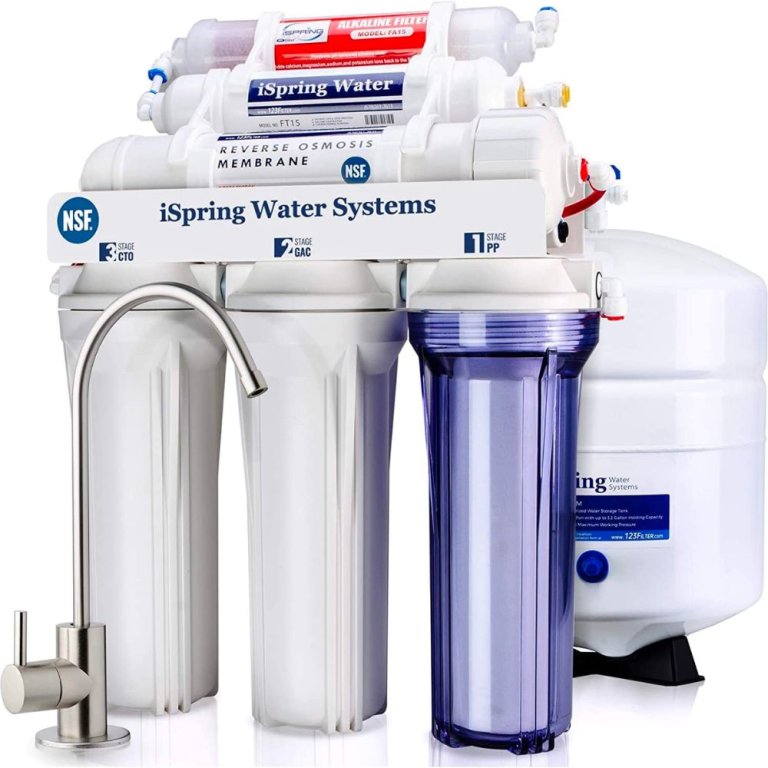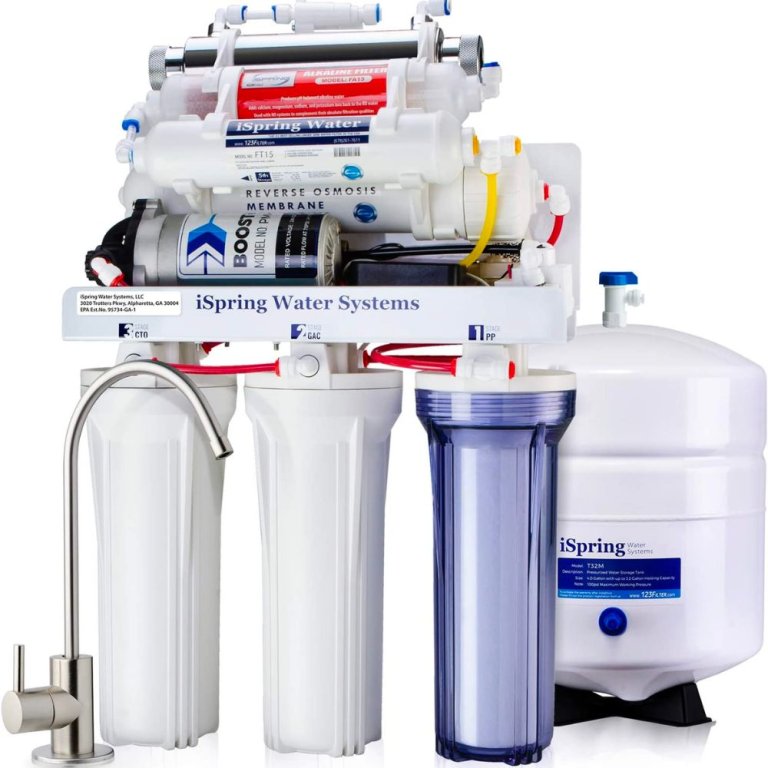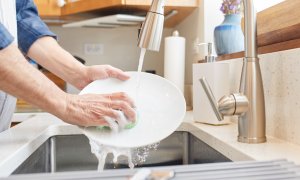
We may earn revenue from the products available on this page and participate in affiliate programs. Learn More ›
If your tap water tastes a little off, leaves spots on your dishes, or you just want the peace of mind that comes with knowing exactly what’s in your glass, a reverse osmosis (RO) system can make a world of difference. These (usually) under-sink units push water through multiple filters and a semipermeable membrane to strip away sediment, heavy metals, and other contaminants, delivering crisp, clean water straight from the faucet.
Through extensive research, we’ve found some of the best RO systems on the market and tested four of them in real homes with chlorinated municipal water. Our top pick, the Apec Water ROES-PH75, impressed us with its reliable performance, mineral-enhancing filter, and long-lasting components. It’s an excellent choice for households that want dependable filtration without complicated maintenance.
In this guide, we’ll explain what to look for when choosing the best reverse osmosis system for your home, how your local water quality should shape your decision, and share several top-tested options to suit different needs and budgets.
- BEST OVERALL: Apec Water ROES-PH75 Essence Reverse Osmosis System
↓ Jump to Review - RUNNER-UP: Waterdrop X12 Pro
↓ Jump to Review - BEST BANG FOR THE BUCK: Home Master TMAFC Full Contact Reverse Osmosis System
↓ Jump to Review - BEST COUNTERTOP: Sans Water Purifier
↓ Jump to Review - BEST TANKLESS: Waterdrop G2 Tankless Reverse Osmosis System
↓ Jump to Review - BEST UNDER-SINK: iSpring RCC7AK 6-Stage Reverse Osmosis System
↓ Jump to Review - BEST FOR WELL WATER: iSpring RCC1UP-AK 7-Stage UnderSink RO System
↓ Jump to Review - BEST RO ICE-MAKER KIT: Apec Water Icemaker Kit for Apec RO System
↓ Jump to Review

Reverse Osmosis Systems Comparison
| Product | Tank Size | Water Output | Filtration Stages |
|---|---|---|---|
| Apec Water ROES-PH75 Essence Reverse Osmosis System | 4 gallons | 75 gallons per day | 6 |
| Waterdrop X12 Pro | Tankless | 1,200 GPD | 11 |
| Home Master TMAFC Full Contact Reverse Osmosis System | 3.2 gallons | 75 gallons per day | 7 |
| Sans Water Purifier | 118-ounce removable reservoir | Countertop (approximately 48 ounces per 3.5-minute cycle) | 4 |
| Waterdrop G2 Tankless Reverse Osmosis System | Tankless | 400 gallons per day | 7 |
| iSpring RCC7AK 6-Stage Reverse Osmosis System | 3.2 gallons | 75 gallons per day | 6 |
| iSpring RCC1UP-AK 7-Stage UnderSink RO System | 2.5 gallons | 100 gallons per day | 7 |
| Apec Water Icemaker Kit for Apec RO System | No tank included | Compatible with most Apec filtration systems | Compatible with most Apec filtration systems |
Our Top Picks
The products below represent the top standard, countertop, and tankless reverse osmosis water filtration systems from the industry’s leading manufacturers. These units feature high output and efficient wastewater-to-purified-water ratios, our own insights from hands-on testing, and thoroughly vetted pros and cons.
Best Overall
Apec Water ROES-PH75 Essence Reverse Osmosis System
Buy at Amazon Buy at Lowe's Buy at The Home DepotWhat We Like
- High-flow design delivers fresh water fast
- Filters last up to one year
- Removes 99% of contaminants, adds minerals
- Easy installation with WQA Gold Seal certification
What We Don’t Like
- Filters may need replacing sooner than expected
- Takes up a lot of space under the sink
Product Specs
- Tank size: 4 gallons
- Water output: 75 gallons per day
- Number of filtration stages: 6
With easy installation and high-capacity filters that last much longer than those of other systems, Apec’s ROES-PH75 is an excellent option for purifying a home’s water. In testing in a new-build Florida home with hard municipal water, the system installed cleanly on the first try and produced noticeably clearer, better-tasting water within the first day of use. Whereas filters on other systems may last for only a few months, the filters on this six-stage system are rated to last for a full year before needing replacement, which helped keep ongoing maintenance simple for the tester.
The system’s six stages remove contaminants and 99 percent of bacteria while also adding essential healthy minerals and calcium for a smoother taste. In daily use, the ROES-PH75 kept up with drinking and cooking needs without running dry, producing up to 75 gallons of treated water each day. A flow restrictor and automatic shut-off valve keep wastewater production to about 3 gallons for every 1 gallon of treated water. The trade-off is space: the 15-inch-long by 11-inch-wide 4-gallon tank takes up a significant portion of the under-sink cabinet, which was very noticeable in our test kitchen.
According to Apec’s own performance data, the ROES-PH75 is rated to remove up to 99 percent of many listed contaminants—including chlorine, fluoride, arsenic, lead, and other heavy metals—while handling feed water with total dissolved solids (TDS) up to 2,000 ppm at typical city water pressure.
What our tester says: “The Apec ROES-PH75 has been rock-solid since day one—it never runs out of water, and the difference in taste and clarity is instantly noticeable. Just make sure you’ve got plenty of space under the sink, because this thing is a beast.” —Paul Rankin, Product Reviews tester and writer.
Get the Apec Water ROES-PH75 reverse osmosis system at Amazon, Lowe’s, or The Home Depot.
Runner-Up
Photo: AmazonWhat We Like
- Easy, intuitive installation
- Compact design saves under-sink space
- Smart faucet with selectable water volumes
- High-quality metal water lines
What We Don’t Like
- LED indicators feel overly bright
Product Specs
- Tank size: Tankless
- Water output: 1,200 GPD
- Number of filtration stages: 11
The Waterdrop X12 Pro is one of the most thoughtfully designed reverse osmosis systems we’ve tested. Unlike bulky under-sink units that hog storage space, this compact, power-assisted system is roughly the size of a slim desktop computer, and just as sleek. Setup was remarkably easy, thanks to quick-connect tubing and clear instructions. Even drilling a hole for the smart faucet felt manageable with the included guide sticker.
Performance-wise, it delivered some of the cleanest, crispest-tasting water in our tests. Waterdrop rates the X12 Pro at up to 1,200 gallons per day with a 3:1 pure-to-drain ratio, and the smart faucet provides real-time TDS and filter-life readouts so you can see performance at a glance. It balanced alkalinity levels, improved carbonate ppm, and made even our regular faucet water noticeably better over time. The stainless-steel lines, slide-out filters, and smart faucet with selectable water volumes add a sense of durability and luxury that most RO systems lack. Our only minor complaint: the LED indicators on the faucet are a bit too prominent.
What our tester says: “The X12 Pro completely changed how I think about under-sink filtration—it’s compact, easy to install, and the water tastes noticeably cleaner from day one.” —Paul Rankin, Product Reviews tester and writer.
Read our full review: Waterdrop X12 review
Get the Waterdrop reverse osmosis system at Amazon, The Home Depot, or Best Buy.
Best Bang for the Buck
Home Master TMAFC Full Contact Reverse Osmosis System
Buy at Amazon Buy at Lowe's Buy at The Home DepotWhat We Like
- All components NSF certified for reliability
- Fast Flo kit boosts flow and easy installation
- Patented mineralization and fine 0.0001-micron filtration
- Complete kit includes tank, faucet, and adapter
What We Don’t Like
- Some users report minor leaks or installation issues
Product Specs
- Tank size: 3.2 gallons
- Water output: 75 gallons per day
- Number of filtration stages: 7
Though all of the reverse osmosis systems on this list are reliable when it comes to removing contaminants and providing clean water, the sight of an NSF certification provides that extra peace of mind and also makes it an exceptional value. This under-sink reverse osmosis system from Home Master comes with this certification, as do all of the other models from the brand. It comes with a patented mineralization system that adds magnesium and calcium twice throughout the filtration process for clean-tasting water and protection against tank degradation.
Included with this system are the purification unit, the filters, the tank, a ⅜-inch adapter with a shut-off valve, a chrome faucet, and a drain saddle, all of which are easy to install wrench-free. The purification unit measures just 16 inches high by 8 inches wide and the tank is 15 inches high by 11 inches in diameter, both of which are compact enough to fit under most sinks without taking up too much room.
This Home Master TMAFC under-sink reverse osmosis system also comes with a Fast Flo RO! Kit with larger fittings and tubing, which allows for a faster flow rate to provide over 75 gallons per day. The lifespan of the filters lasts up to 2,000 gallons before requiring any replacements. This Home Master has seven stages of filtration with catalytic carbon and sediment filters included that are capable of filtering contaminants, chemicals, and chlorine of up to 0.0001 microns in size, providing excellent-tasting clean water.
The manufacturer’s specs describe a seven‑stage filtration and remineralization system with a Fast Flo kit to improve flow and highly efficient wastewater performance (near 1:1 with the permeate‑pump upgrade), and they claim up to roughly 98 to 99 percent removal of many dissolved solids, chemicals, and metals.
What our tester says: “I’m a stickler for good-tasting water and crystal-clear iced tea. After several years of renting an RO unit from a national water specialist, we installed the Home Master TMAFC Full Contact reverse osmosis system. It has a fast fill rate so there’s always clean water for drinking and cooking. We liked the TMAFC so much, we bought a second unit for the sink in our master suite.” —Glenda Taylor, Product Reviews tester and staff writer.
Get the Home Master reverse osmosis system at Amazon, Lowe’s, or The Home Depot.
Best Countertop
Sans Water Purifier
Buy at SansWhat We Like
- Zero installation—plug and play setup
- Compact countertop design (under 1 cubic foot)
- On-demand hot water dispenser (180°F)
- Real-time TDS readout
- Quiet operation (37 decibels)
What We Don’t Like
- No fill line on reservoir (just floating “Max” indicator)
- No control-panel lock for child safety
Product Specs
- Tank size 118-ounce removable reservoir
- Water output Countertop (approximately 48 ounces per 3.5-minute cycle)
- Number of filtration stages 4
The Sans Water Purifier makes reverse osmosis accessible for renters and anyone who wants clean water without plumbing modifications. This countertop unit requires no drilling or under-sink installation. You simply plug it in, fill the reservoir, and start filtering. Its four-stage process (sediment/carbon prefilter, RO membrane, VOC carbon filter, and UV-C light) removes up to 99.9 percent of contaminants, including PFAS, heavy metals, fluoride, chlorine, and even bacteria and viruses, confirmed by independent testing.
Setup takes minutes with preinstalled filters, and the system automatically starts filtering when you insert the water tank. The 48-ounce glass pitcher fills in about 3.5 minutes, and the unit doubles as an instant hot-water dispenser. Filter life indicators show when it’s time to replace filters, and maintenance is minimal. While it lacks NSF certification, extensive testing, and user reviews support its performance claims. An optional Mineral Boost filter reintroduces beneficial minerals for those concerned about RO stripping them out.
What our tester says: “I’ve never considered buying a reverse osmosis system because they seemed hard to install and not renter-friendly. The Sans feels more like a small appliance than an intimidating plumbing project. It sets up in minutes, takes up minimal counter space, and produces noticeably cleaner-tasting water than standard pitchers.” —Michelle Larson, Product Reviews writer.
Get the Sans Water Purifier at Sans.
More Great Options
While we didn’t test the options below, we think that their impressive features and overwhelmingly positive reviews make them worth a look.
Best Tankless
Photo: AmazonWhat We Like
- Compact tankless design saves valuable under-sink space
- High flow rate with minimal wastewater
- Only two quick-change filters required
- Long-lasting filters up to 24 months
What We Don’t Like
- Higher upfront and replacement filter costs
Product Specs
- Tank size: Tankless
- Water output: 400 gallons per day
- Number of filtration stages: 7
Two of the biggest complaints about RO systems are the massive tank that takes up a lot of the space under the kitchen sink and the limitations in purified water capacity. Reclaim that space and multiply your purified water output with this tankless RO system from Waterdrop. This system takes up 70 percent less cabinet real estate while boosting your purified water to a whopping 400 gallons per day.
The Waterdrop also produces faster water flow, filling a cup with filtered water much faster than a standard system. The system includes compact filters that remove multiple contaminants, resulting in a unit that takes up less space. The filter design also means the filters will last much longer than the standard 6 months. When it is time to replace them, removing the filters is an easy twist-and-pull process.
Get the Waterdrop reverse osmosis system at Amazon, Walmart, or Waterdrop.
Best Under-Sink
Photo: AmazonWhat We Like
- Affordable system with alkaline remineralization filter
- Removes lead, arsenic, and other contaminants
- Solid-brass faucet with quick push-fit connectors
What We Don’t Like
- Water pressure may feel slightly restricted
Product Specs
- Tank size: 3.2 gallons
- Water output: 75 gallons per day
- Number of filtration stages: 6
Capacity is often an issue when it comes to under-sink RO systems; a typical customer complaint is that their RO system just doesn’t produce enough water. That’s not the case with this system, which produces up to 75 gallons of purified water each day—more than enough for most households.
And while many RO filter systems stop at five stages, iSpring adds a sixth stage, which includes a remineralization filter that adds healthy minerals removed in the previous stages back into the water. In addition to its capacity and filtration system, owners also love the modern brushed-nickel look for the faucet, which adds both elegance and purified water to a kitchen.
Get the iSpring RCC7AK reverse osmosis system at Amazon, Lowe’s, The Home Depot, or Walmart.
Best for Well Water
Photo: AmazonWhat We Like
- UV light eliminates bacteria in well water
- Booster pump maintains flow and reduces waste
- Durable brass faucet with ceramic valve
What We Don’t Like
- Large, expensive system requires ample under-sink space
Product Specs
- Tank size: 2.5 gallons
- Water output: 100 gallons per day
- Number of filtration stages: 7
Because well water comes directly from the ground, it can sometimes require a significant amount of processing to filter out impurities and make the water palatable for drinking. With its seven-stage system, iSpring offers maximum filtration. In addition to removing harmful pollutants, this system includes an alkaline remineralization filter that restores healthy minerals while providing an alkaline balance that improves taste.
The system includes a crucial UV stage, which effectively removes harmful bacteria and is a must-have for those on well water. Customers say they love the taste of the water produced by this filtration system. The iSpring features a 2.5-gallon storage tank for a 100-gallon-per-day capacity, producing plenty of drinking water for a household.
Get the iSpring RCC1UP-AK reverse osmosis system at Amazon, Lowe’s, or The Home Depot.
Best RO Ice-Maker Kit
Photo: AmazonWhat We Like
- Connects RO systems to refrigerator ice makers
- Purifies better than standard fridge filters
- Includes shut-off valve and 20 feet tubing
What We Don’t Like
- Push-fit connectors require careful installation
Product Specs
- Tank size: No tank included
- Water output: Compatible with most Apec filtration systems
- Number of filtration stages: Compatible with most Apec filtration systems
What good is purified water if you can drink only lukewarm glasses of it? One solution is to start filling ice-cube trays. A better solution is to connect your RO system to your refrigerator’s ice maker with this kit, which allows you to create pure ice cubes to go with the purified water from your RO system.
This kit will work with most water filter systems using ¼-inch tubing. It includes 20 feet of ¼-inch tubing and two quick-connect fittings for making the connection to your fridge. Make sure you have an easy way to run this line from your RO system to your fridge to ensure a seamless installation.
Get the Apec Water ice maker kit for reverse osmosis systems at Amazon or The Home Depot.
Jump to Our Top Picks
How We Tested the Best Reverse Osmosis Systems

We started by researching dozens of popular RO systems from leading brands, comparing tank capacity, daily water output (GPD), filtration stages, membrane type, and maintenance requirements. Our final list includes compact countertop models as well as large under-sink and tankless systems capable of filtering up to 1,200 gallons per day. We looked for products that publish clear performance data and third-party certifications, prioritizing systems tested to NSF/ANSI standards such as 58 and 372 or carrying a WQA Gold Seal for proven safety and long-term reliability.
We didn’t just rely on specs—we installed four of the most promising systems in real kitchens and used them for several months. Each unit was hooked up to a chlorinated municipal water supply and flushed according to the manufacturer’s instructions before testing. We used digital TDS meters and multi-parameter water test kits to measure total dissolved solids, hardness, chlorine, and other basic indicators before and after filtration, then compared flow rate, refill speed, and overall taste. For example, our test home in Florida started with tap water in the “moderately hard” range and significantly reduced TDS once the RO system had stabilized. The readings on our digital water tester measured 307 ppm from the raw tap water, which dropped to just 15 ppm for the filtered water.
We also pulled each tester’s local Consumer Confidence Report (CCR) to understand the baseline water profile—whether the source water already meets federal standards for contaminants like lead, nitrate, and arsenic, and whether hardness or TDS levels are especially high. You can look up the same reports through the EPA’s Consumer Confidence Report tool to see which contaminants matter most in their area and choose an RO system accordingly.
Finally, we evaluated usability: how much room the system took under the sink or on the counter, how intuitive the connections were, and whether features like smart faucets, filter-life indicators, booster pumps, or permeate pumps actually made day-to-day use easier. Systems that combined strong contaminant reduction with reasonable wastewater ratios and simple DIY maintenance scored highest overall.
What to Consider When Choosing a Reverse Osmosis System
There are a number of factors to consider when shopping for a reverse osmosis system, including whether you need to filter tap or well water, your plumbing requirements, desired water output, the number of filtering stages, and how efficient the system is with wastewater. Just as important, the “right” RO system depends on your local water quality—what’s in your water to begin with will determine which features you actually need.
Know Your Local Water Quality
Before you get your heart set on a specific RO system, it’s worth learning a bit about your tap water. If you’re on municipal water, your provider is required to publish an annual Consumer Confidence Report (CCR) that lists hardness, TDS, and contaminant levels like lead, nitrates, and arsenic. You can look up yours through the EPA’s CCR search tool or local drinking water pages.
Water hardness and TDS are especially important. The U.S. Geological Survey classifies water from 0 to 60 mg/L as “soft,” 61 to 120 mg/L as “moderately hard,” 121 to 180 mg/L as “hard,” and more than 180 mg/L as “very hard.”
If your water is very hard or has a lot of iron, you may need a system that’s rated for higher TDS and hardness or to install a sediment filter or softener upstream so the RO membrane doesn’t foul prematurely.
On the other hand, if your CCR shows low TDS and few contaminants, you may not need an 11-stage system with UV and deionization—an efficient four- or five-stage unit might be plenty.
Plumbing Requirements
Before purchasing a reverse osmosis system, it’s essential to consider a few plumbing factors. Start by checking out the space under your kitchen sink. Because it uses multiple filters and a large storage tank, a reverse osmosis system takes up a lot of real estate. That means items stored under your sink will have to go. And if you have a garbage disposal, it may be challenging to fit a reverse osmosis system below the sink.
You’ll also need to assess the top of your sink. RO systems require a separate faucet, which typically sits adjacent to your standard kitchen faucet. This means you’ll need to install a second faucet at your sink either by drilling through the sink edge or the countertop.
RO systems also use a dedicated air-gap faucet. This removes impurities by separating them from the water supply in liquid form. That liquid must then be discharged through an air gap that drips the wastewater into an outlet tube connected to the sink drain. An air-gap faucet prevents contaminated water from being drawn back into the RO system’s discharge side. If the faucet is not near the RO system and is therefore not sharing a discharge line, there is no need for an air-gap faucet; otherwise, purchase a system with an air-gap faucet.
Water Output
Even though an RO faucet will dispense water quickly, traditional tank-style systems refill the storage tank at a relatively slow rate, often around 50 to 75 gallons per day under ideal pressure and temperature conditions. That translates into a water output of about 1 gallon every 30 minutes.
If you only plan to use RO water for drinking and cooking, a 50- to 75-GPD under-sink system is usually sufficient. Larger households, serious home cooks, or people filling pet bowls, humidifiers, and ice makers from their RO tap may want a high-output system rated 90 GPD or more, or a tankless design that can produce several hundred to over 1,000 gallons per day. Tankless systems like high-capacity 1,200 GPD units are designed to keep up with bigger families and multiple water demands at once.
Wastewater
One criticism of reverse osmosis water filtration systems is that they create a lot of wastewater. Unlike standard filters, which trap solid contaminants as water passes through, RO membranes reject dissolved solids in liquid form, creating wastewater called brine. Older or budget systems can produce several gallons of brine—sometimes 3 or 4 gallons or more—for every gallon of purified water
Many under-sink systems now advertise wastewater-to-purified-water ratios around 2:1 or even 1:1. If you live in a drought-prone area or simply want to minimize waste, it’s worth paying attention to these specs and choosing a more efficient design.
The EPA awards the WaterSense label to RO systems that produce 2.3 gallons or less of wastewater for every gallon of treated water. This is a quick way to see whether an RO is particularly wasteful or not.
Tank Size
RO storage tanks range in size from 3 gallons to 14 gallons, but tank size can be a bit deceiving. The actual storage tank capacity will be less than the rated volume because RO storage tanks contain a bladder and an air pocket to create pressure. For example, a 4.5-gallon storage tank will hold around 2 to 3 gallons of water.
As you shop, think about how much RO water your household uses in a typical day and whether you prefer a compact tank that refills more often or a larger tank that takes up more under-sink space but provides more water per fill. If under-sink space is tight or you just don’t want a tank at all, a tankless RO system can be a smart alternative.
Membrane Type, Rejection Rate, and Certifications
The RO membrane is the heart of the system. Most residential units use thin-film composite (TFC) membranes that remove roughly 90 to 99 percent of dissolved solids, including heavy metals and salts, though some membranes are optimized for specific contaminants like nitrates.
When comparing systems, look for manufacturer performance sheets or certifications that verify those “up to 99%” claims.
- NSF/ANSI 58 confirms contaminant-reduction performance
- NSF/ANSI 372 ensures lead-free construction
- Many top models also carry the WQA Gold Seal
If your water report shows any problem contaminants, like arsenic, chromium, or nitrates, make sure the RO system specifically targets those contaminants.
Performance
Because no single filter can remove all contaminants by itself, the best reverse osmosis systems use multiple filter types—called stages—for peak performance. Water quality experts generally agree that four stages (sediment, carbon, RO membrane, and a post-filter) are enough to purify most municipal water. That said, some systems stack on additional stages for specific purposes:
- Extra carbon blocks to target chlorine and volatile organic compounds (VOCs)
- UV sterilization to neutralize microorganisms in well water
- Remineralization cartridges to add back calcium and magnesium for better taste
- Deionization (DI) stages to polish water for aquariums or lab-style applications
More stages don’t automatically mean better water, but they can help fine-tune taste or tailor the system to tricky water profiles. Focus on what each stage does and whether it addresses something that shows up in your local water report.
High-Pressure Pump
For an RO system to work, it needs water pressure of at least 50 pounds per square inch (psi). Most homes have water pressure between 30 and 80 psi. This high pressure is needed to push the water through the various reverse osmosis filters and still maintain adequate pressure at the tap.
If your home has low pressure (like on a well system), an RO booster pump increases the water pressure at the system to up to 80 psi. Even homes that operate on standard city water pressure of 60 psi can benefit from a pump, as an RO system will run better at 80 psi or higher.
Valves
Water enters the system by passing through an RO membrane and then into the tank. RO systems have a shut-off valve, which is a one-way valve that prevents water in the storage tank from backflowing into the membrane when the tank is full.
Once the tank is full, this spring-operated valve engages, stopping the flow of water back against the reverse osmosis membrane, effectively holding it in the tank. The valve automatically reopens when the tank’s pressure drops enough to allow water to enter the RO system again. Though tiny and inexpensive, this valve is crucial to the proper functioning of the RO system.
Ease of Installation and Maintenance
Ease of installation will depend on the reverse osmosis system chosen, and it’s always important to follow the maker’s instructions carefully. There are often online videos available that can provide invaluable help.
Countertop models are the simplest as these don’t require any plumbing. Just plug the unit in, fit the required filters, fill, and wait for the water to pass through. The disadvantage of course is that someone has to remember to refill the tank from time to time.
Under-sink reverse osmosis systems have the advantage of providing water on demand. They need a cold-water feed, a connection to the drain for wastewater, and a mounting spot for a dedicated faucet. These will normally be easily accessible from under the sink.
While you could call a plumber, fitting an RO system is not a difficult process. Most manufacturers suggest that a competent DIYer could complete the job in around 2 hours, and many homeowners will already possess the basic tools required.
Finally, the filters need to be attached, though these usually have simple twist connectors
The Advantages of Owning a Reverse Osmosis System
Reverse osmosis water treatment systems offer a bevy of health benefits that make them a worthy investment for your home. The filtration process removes bacteria and microorganisms and impurities, such as arsenic, chromium, and other chemical contaminants.
In addition to making healthier drinking water, RO systems also make drinking water tastier. The contaminants in water can cause bitter tastes and foul smells. When RO systems remove these contaminants, the water smells and tastes cleaner.
Although it may not seem this way when you make the initial investment in an RO system, it can save you money. Purchasing bottled water from a grocery store is considerably more expensive than filtering your own water.
And while there is some debate about the impact of RO systems on the environment due to the amount of wastewater produced, they do the environment a favor by reducing the creation of plastic waste that comes from bottled water.
- RO filtration systems offer health benefits by removing impurities, bacteria, and microorganisms from drinking water.
- They improve the taste of drinking water.
- They save money by eliminating the need for bottled water purchases.
- They help the environment by reducing plastic bottle waste.
How to Install a Reverse Osmosis System by Yourself
Save yourself a steep plumber’s bill and read on to learn how to install a reverse osmosis water filtration system yourself.
- Shut off the cold water shut-off valve. Turn the shut-off valve clockwise to shut off the water.
- Open the faucet. This will empty the water left in the lines, minimizing leakage when you disconnect the sink’s supply valve.
- Disconnect the water line from the shut-off valve. Use a pair of pliers to unscrew and detach the supply line. Have a towel or cup handy to catch residual water in the lines.
- Connect the cold water line to the RO system. Using the adapter provided by the RO system, connect the cold water supply line to your system.
- Turn on the cold water supply valve.
- Install the filter and tank. Position the filter and tank under the sink.
- Install the drain line. Locate the system’s drain line. Drill a hole in the sink’s existing waste line, and install the waste line so your system can drain its wastewater here.
- Install the new faucet. If your sink has a predrilled hole, use this to install the new faucet. Otherwise, you’ll need to drill a new hole in the sink or countertop to mount the new faucet.
- Install the new faucet. Once the faucet is installed, the supply line attaches to the output of the RO system.
- Connect the reservoir tank to the filter system. Follow the manufacturer’s instructions to make a proper connection.
FAQs
Osmosis is the process of passing water molecules through a semipermeable membrane from a less-concentrated solution into a more concentrated solution. RO water filtration systems work by passing water through a semipermeable membrane under pressure. The reverse osmosis membrane allows water molecules to pass through but does not allow larger molecules such as bacteria, viruses, urea sodium, and chlorine to pass through.
Reverse osmosis water filtration systems remove harmful bacteria, viruses, sediment, dirt, and a long list of toxic chemicals and compounds, including arsenic, copper, radium, cadmium, and lead.
Because the distillation system cannot altogether remove every trace of chlorine and certain pesticides and herbicides from water, RO filtration systems are more effective at purifying water.
The difference between a single-pass and double-pass RO system is that the water produced from the first pass feeds back through the system again as the feed water for the second pass. This means the water goes through the system twice, creating a higher quality of purified water.
Because RO systems do waste a considerable amount of water, they impact the environment. The average RO filtration system produces about 4 gallons of wastewater per gallon of purified water. That said, RO systems reduce the consumption of bottled water, which is considerably more damaging to the environment due to the use of nonbiodegradable plastic bottles.
Yes. RO systems remove most contaminants, improving both water safety and taste.
It depends. Under-sink systems offer higher capacity, while countertop units are easier to install.
Most systems last 10 to 15 years with regular filter changes. Filters typically need to be replaced every 6-12 months.
